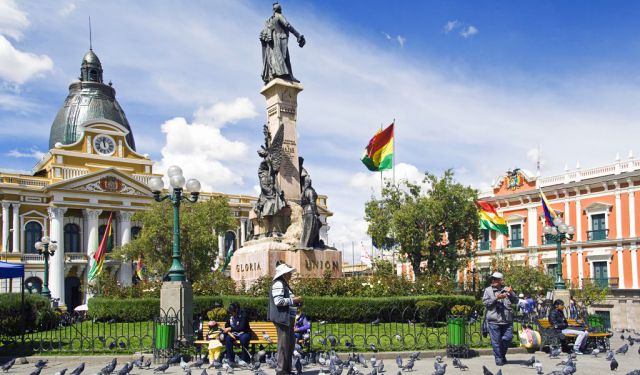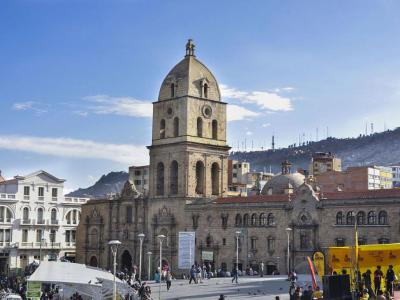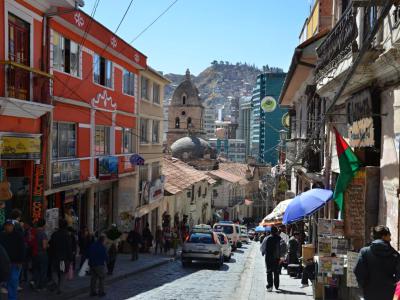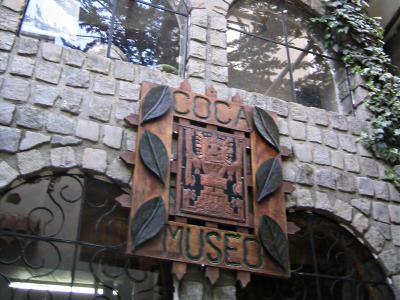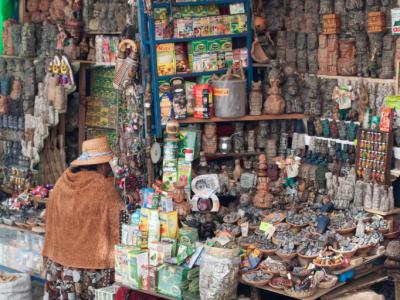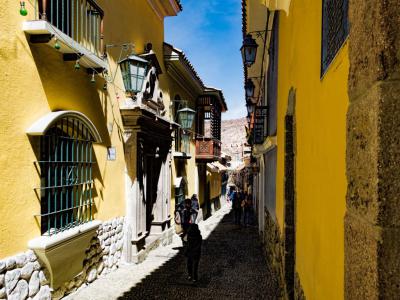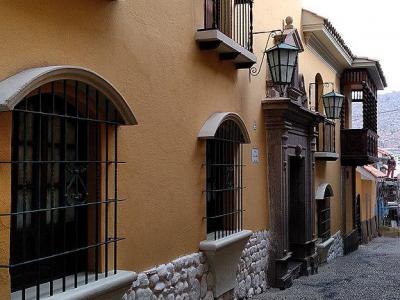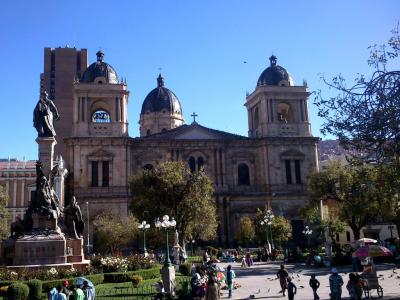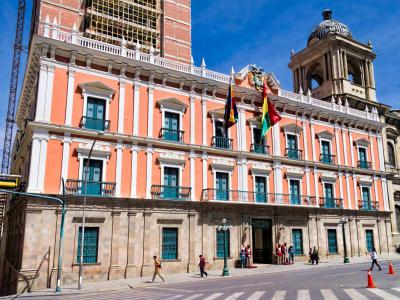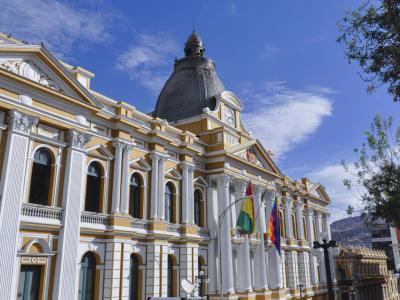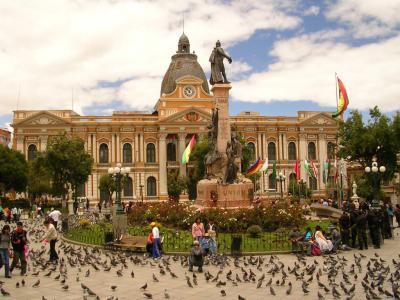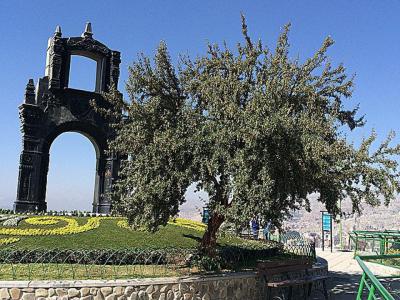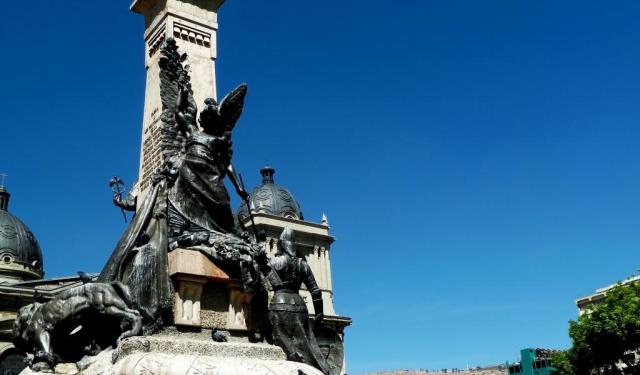La Paz Introduction Walking Tour (Self Guided), La Paz
Nestled like a jewel within the cradle of the Andean highlands, over 3,500 meters above sea level, La Paz, Bolivia, is the most elevated capital city in the world. Curiously, it is one of Bolivia's two capitals (the other one is Sucre).
La Paz was founded on the site of a small Inca settlement, in 1548, by the Spanish conquistador Alonso de Mendoza, and was originally named Nuestra Señora de La Paz (which means Our Lady of Peace). Such a name was given to commemorate the restoration of peace after the insurrection of conquistadors, led by Gonzalo Pizarro, against the viceroy of Peru.
The city's location in a high-altitude valley, much as its closeness to silver mines, made it a strategic destination in South America. La Paz quickly grew and, during the colonial period, played a significant role as an administrative and economic hub for the Spanish crown. In 1825, Bolivia gained independence from Spain, following which La Paz continued to evolve within the newly-formed republic.
Gracing the cityscape with an elegant reverence, the 16th-century Basilica of San Francisco (Iglesia de San Francisco) is a timeless bastion of Andean Baroque and a testament to the fusion of artistic expression that permeates La Paz.
Winding through the city's center, the bustling Sagarnaga Street exudes a tantalizing charm. This cobbled promenade is a great place to explore traditional Bolivian culture and pick up unique mementos.
Enigmatic and mystic, the Witches' Market (Mercado de las Brujas) ensnares the senses with a beguiling alchemy of scents and sights. Here, enshrouded in the mystical aura of indigenous rituals, curious seekers are granted passage to the enduring traditions of Bolivian spiritualism.
In the very heart of the city, the emblematic Murillo Square (Plaza de Murillo) is where the chapters of Bolivia's historical odyssey unfold. Encircled by governmental buildings and crowned by a monolithic ode to independence, this public stage invites all who tread its stones to be touched by the spirit of national pride.
Finally, high above the realm of mortal endeavors, a celestial coronet of the Killi Killi Lookout (Killi Killi Mirador) crowns the cityscape. From this perch, La Paz reveals its panoramic splendor, a tapestry of mountaintops and valleys, inviting pilgrims of beauty to embrace its grandeur.
Amid its rarified air, La Paz boasts an opulent array of breathtaking attractions and beguiling allure. If you're interested in exploring Bolivia's unique heritage, the best place to start is the country's capital on this self-guided walk.
La Paz was founded on the site of a small Inca settlement, in 1548, by the Spanish conquistador Alonso de Mendoza, and was originally named Nuestra Señora de La Paz (which means Our Lady of Peace). Such a name was given to commemorate the restoration of peace after the insurrection of conquistadors, led by Gonzalo Pizarro, against the viceroy of Peru.
The city's location in a high-altitude valley, much as its closeness to silver mines, made it a strategic destination in South America. La Paz quickly grew and, during the colonial period, played a significant role as an administrative and economic hub for the Spanish crown. In 1825, Bolivia gained independence from Spain, following which La Paz continued to evolve within the newly-formed republic.
Gracing the cityscape with an elegant reverence, the 16th-century Basilica of San Francisco (Iglesia de San Francisco) is a timeless bastion of Andean Baroque and a testament to the fusion of artistic expression that permeates La Paz.
Winding through the city's center, the bustling Sagarnaga Street exudes a tantalizing charm. This cobbled promenade is a great place to explore traditional Bolivian culture and pick up unique mementos.
Enigmatic and mystic, the Witches' Market (Mercado de las Brujas) ensnares the senses with a beguiling alchemy of scents and sights. Here, enshrouded in the mystical aura of indigenous rituals, curious seekers are granted passage to the enduring traditions of Bolivian spiritualism.
In the very heart of the city, the emblematic Murillo Square (Plaza de Murillo) is where the chapters of Bolivia's historical odyssey unfold. Encircled by governmental buildings and crowned by a monolithic ode to independence, this public stage invites all who tread its stones to be touched by the spirit of national pride.
Finally, high above the realm of mortal endeavors, a celestial coronet of the Killi Killi Lookout (Killi Killi Mirador) crowns the cityscape. From this perch, La Paz reveals its panoramic splendor, a tapestry of mountaintops and valleys, inviting pilgrims of beauty to embrace its grandeur.
Amid its rarified air, La Paz boasts an opulent array of breathtaking attractions and beguiling allure. If you're interested in exploring Bolivia's unique heritage, the best place to start is the country's capital on this self-guided walk.
How it works: Download the app "GPSmyCity: Walks in 1K+ Cities" from Apple App Store or Google Play Store to your mobile phone or tablet. The app turns your mobile device into a personal tour guide and its built-in GPS navigation functions guide you from one tour stop to next. The app works offline, so no data plan is needed when traveling abroad.
La Paz Introduction Walking Tour Map
Guide Name: La Paz Introduction Walking Tour
Guide Location: Bolivia » La Paz (See other walking tours in La Paz)
Guide Type: Self-guided Walking Tour (Sightseeing)
# of Attractions: 11
Tour Duration: 2 Hour(s)
Travel Distance: 2.8 Km or 1.7 Miles
Author: valery
Sight(s) Featured in This Guide:
Guide Location: Bolivia » La Paz (See other walking tours in La Paz)
Guide Type: Self-guided Walking Tour (Sightseeing)
# of Attractions: 11
Tour Duration: 2 Hour(s)
Travel Distance: 2.8 Km or 1.7 Miles
Author: valery
Sight(s) Featured in This Guide:
- Iglesia de San Francisco (San Francisco Church)
- Sagarnaga Street
- Museo de la Coca (Coca Museum)
- Mercado de Las Brujas (Witches' Market)
- Jaen Street and its Museums
- Casa Murillo (Murillo House)
- Metropolitan Cathedral of La Paz
- Palacio de Gobierno (Government Palace)
- Palacio Legislativo (Legislative Palace)
- Plaza de Murillo (Murillo Square)
- Mirador Killi Killi (Killi Killi Lookout)
1) Iglesia de San Francisco (San Francisco Church) (must see)
The San Francisco Church is a remarkable hewed stone basilica with a rich history. It was founded in 1548 by Fray Francisco de los Ángeles. However, the original structure suffered a collapse due to heavy snowfall around 1610. Nonetheless, the church was rebuilt between 1743 and 1772, using stone quarried from the nearby Viacha area.
The facade of the second building is adorned with intricate carvings depicting natural themes such as chirimoyas (custard apples), pine cones, and tropical birds. These artistic details add to the beauty and charm of the church, showcasing the craftsmanship of the period.
Adjacent to the basilica, you will find the cloisters and garden of the Museo San Francisco. This museum beautifully showcases the history and art associated with the city's landmark. Inside, visitors can marvel at heavenly religious paintings, historical artifacts, and an interesting anteroom. For a unique perspective, the museum offers a fantastic view from its roof, allowing visitors to take in the panoramic scenery of La Paz.
The upper portion of Plaza San Francisco, where the church is located, features a mass of rock pillars and stone faces. This arrangement symbolizes Bolivia's three great cultures: Tiwanaku, Inca, and modern Aymará. It serves as a tribute to the rich cultural heritage of the region, honoring its indigenous roots.
As one of the city's focal points, Plaza San Francisco often serves as a gathering place for rallies and protests. The square's significance extends beyond its architectural and cultural value, playing a role in the social and political life of La Paz.
The San Francisco Church stands as a testament to the enduring legacy of Bolivia's history and showcases the captivating blend of art, culture, and spirituality that is deeply ingrained in the fabric of La Paz.
The facade of the second building is adorned with intricate carvings depicting natural themes such as chirimoyas (custard apples), pine cones, and tropical birds. These artistic details add to the beauty and charm of the church, showcasing the craftsmanship of the period.
Adjacent to the basilica, you will find the cloisters and garden of the Museo San Francisco. This museum beautifully showcases the history and art associated with the city's landmark. Inside, visitors can marvel at heavenly religious paintings, historical artifacts, and an interesting anteroom. For a unique perspective, the museum offers a fantastic view from its roof, allowing visitors to take in the panoramic scenery of La Paz.
The upper portion of Plaza San Francisco, where the church is located, features a mass of rock pillars and stone faces. This arrangement symbolizes Bolivia's three great cultures: Tiwanaku, Inca, and modern Aymará. It serves as a tribute to the rich cultural heritage of the region, honoring its indigenous roots.
As one of the city's focal points, Plaza San Francisco often serves as a gathering place for rallies and protests. The square's significance extends beyond its architectural and cultural value, playing a role in the social and political life of La Paz.
The San Francisco Church stands as a testament to the enduring legacy of Bolivia's history and showcases the captivating blend of art, culture, and spirituality that is deeply ingrained in the fabric of La Paz.
2) Sagarnaga Street (must see)
Sagarnaga Street is named in honor of Juan Bautista Sagárnaga, a hero of the Revolution of La Paz. It was designed as part of the city's first urban layout with European characteristics, following its founding. The street is situated in the most established part of the city, characterized by a checkerboard pattern, typical of Spanish-planned cities in the New World.
Originally, Sagarnaga Street was home to several tambos, including the Harinas tambo, where the image of the Virgen de Remedios was housed before being transferred to a church.
The street is surrounded by numerous heritage buildings, many of which have been declared National Monuments. These include the Basilica of San Francisco, the San Francisco Museum Cultural Center, the Republic Gallery Building, the Kautsch Hardware Building, and various other buildings stretching from Mariscal Santa Cruz Avenue to Illampu Avenue.
Due to its high pedestrian and vehicular traffic, regular maintenance work is conducted on Sagarnaga Street. In 2011, the most recent maintenance project was carried out, which involved expanding pedestrian areas to accommodate the increasing flow of pedestrians.
In 2013, a remodeling project was undertaken, giving the street its current appearance. The renovation incorporated a combination of cobblestone and concrete flooring, along with the installation of a central channel for effective water drainage. This design improvement ensures the safety of pedestrians in the area during rainfall.
Originally, Sagarnaga Street was home to several tambos, including the Harinas tambo, where the image of the Virgen de Remedios was housed before being transferred to a church.
The street is surrounded by numerous heritage buildings, many of which have been declared National Monuments. These include the Basilica of San Francisco, the San Francisco Museum Cultural Center, the Republic Gallery Building, the Kautsch Hardware Building, and various other buildings stretching from Mariscal Santa Cruz Avenue to Illampu Avenue.
Due to its high pedestrian and vehicular traffic, regular maintenance work is conducted on Sagarnaga Street. In 2011, the most recent maintenance project was carried out, which involved expanding pedestrian areas to accommodate the increasing flow of pedestrians.
In 2013, a remodeling project was undertaken, giving the street its current appearance. The renovation incorporated a combination of cobblestone and concrete flooring, along with the installation of a central channel for effective water drainage. This design improvement ensures the safety of pedestrians in the area during rainfall.
3) Museo de la Coca (Coca Museum)
The Coca Museum offers visitors an opportunity to delve into the intriguing world of the sacred coca leaf. Despite its slightly tired appearance, the museum provides a comprehensive exploration of the leaf's significance in traditional societies, its utilization by the soft-drink and pharmaceutical industries, and the emergence of cocaine as a recreational drug.
The museum's displays are educational, thought-provoking, and present a balanced perspective on the subject matter. Visitors are encouraged to request translations in their preferred language to fully engage with the exhibits and gain a deeper understanding of the topics discussed.
In addition to the informative displays, the Coca Museum features an on-site café that offers a unique culinary experience. Guests can indulge in cocktails, sweets, and even nachos, all crafted using coca as an ingredient. This aspect of the museum provides a tangible connection to the cultural significance of coca, allowing visitors to taste and appreciate its flavors in a variety of culinary delights.
The Coca Museum in La Paz serves as a valuable resource for those seeking knowledge about the historical, cultural, and controversial aspects surrounding the coca leaf. By providing a platform for exploration and understanding, it contributes to a broader conversation about the complex relationship between traditional uses of coca, its commercial applications, and its association with illicit substances.
The museum's displays are educational, thought-provoking, and present a balanced perspective on the subject matter. Visitors are encouraged to request translations in their preferred language to fully engage with the exhibits and gain a deeper understanding of the topics discussed.
In addition to the informative displays, the Coca Museum features an on-site café that offers a unique culinary experience. Guests can indulge in cocktails, sweets, and even nachos, all crafted using coca as an ingredient. This aspect of the museum provides a tangible connection to the cultural significance of coca, allowing visitors to taste and appreciate its flavors in a variety of culinary delights.
The Coca Museum in La Paz serves as a valuable resource for those seeking knowledge about the historical, cultural, and controversial aspects surrounding the coca leaf. By providing a platform for exploration and understanding, it contributes to a broader conversation about the complex relationship between traditional uses of coca, its commercial applications, and its association with illicit substances.
4) Mercado de Las Brujas (Witches' Market) (must see)
The Witches' Market is a fascinating and unique destination that lies just around the corner from the popular Alpaca market. Although it may be hidden, it is impossible to miss due to its intriguing and captivating nature. Whether you are a believer in natural medicine and the occult or simply a curious novice, this peculiar market is sure to astonish and amaze you.
At the Witches' Market, you will find a wide array of potions, spells, and mystical items that claim to assist with a variety of problems. Many of the objects and rituals are intended to bring luck, love, fertility, or financial prosperity. As you explore the market, you can encounter a range of peculiar items for sale, including snakes, statues of naked couples, dried frogs and turtles, aphrodisiacs, owl feathers, armadillos, and uniquely shaped black candles. One of the most haunting objects you will come across is the dried llama fetus, which is a prominent feature of the market. However, if such items make you uneasy, there is an alternative in the form of spell boxes. These boxes come in different sizes and colors and contain pre-made spells that do not require any macabre objects or rituals.
In addition to these intriguing objects, the Witches' Market offers classic items such as amulets adorned with various symbolic images. Among the popular symbols, you will find representations of the sun and the three animal patrons of Incan mythology. The puma symbolizes power, the snake represents wisdom and cunning, and the condor signifies travel and change.
The market is also frequented by Yatiri, or witch doctors, who are believed to have connections to the supernatural realm and possess the ability to tell fortunes. Recognizable by their distinctive hats and often seen carrying a coca pouch, they roam the market in search of clients. They may also be found near churches, offering pagan ceremonies. If you are interested in seeking spiritual guidance or seeking a cure for an ailment, it is advised to approach such matters with caution. While the authenticity of their magic cannot be definitively confirmed, there may be something intriguing about their practices.
The Witches' Market in La Paz presents a captivating blend of folklore, traditional beliefs, and mysticism. Whether you are seeking an unusual souvenir, an insight into local customs, or simply an immersive cultural experience, this market provides a glimpse into the intriguing world of spiritualism and mystic traditions.
At the Witches' Market, you will find a wide array of potions, spells, and mystical items that claim to assist with a variety of problems. Many of the objects and rituals are intended to bring luck, love, fertility, or financial prosperity. As you explore the market, you can encounter a range of peculiar items for sale, including snakes, statues of naked couples, dried frogs and turtles, aphrodisiacs, owl feathers, armadillos, and uniquely shaped black candles. One of the most haunting objects you will come across is the dried llama fetus, which is a prominent feature of the market. However, if such items make you uneasy, there is an alternative in the form of spell boxes. These boxes come in different sizes and colors and contain pre-made spells that do not require any macabre objects or rituals.
In addition to these intriguing objects, the Witches' Market offers classic items such as amulets adorned with various symbolic images. Among the popular symbols, you will find representations of the sun and the three animal patrons of Incan mythology. The puma symbolizes power, the snake represents wisdom and cunning, and the condor signifies travel and change.
The market is also frequented by Yatiri, or witch doctors, who are believed to have connections to the supernatural realm and possess the ability to tell fortunes. Recognizable by their distinctive hats and often seen carrying a coca pouch, they roam the market in search of clients. They may also be found near churches, offering pagan ceremonies. If you are interested in seeking spiritual guidance or seeking a cure for an ailment, it is advised to approach such matters with caution. While the authenticity of their magic cannot be definitively confirmed, there may be something intriguing about their practices.
The Witches' Market in La Paz presents a captivating blend of folklore, traditional beliefs, and mysticism. Whether you are seeking an unusual souvenir, an insight into local customs, or simply an immersive cultural experience, this market provides a glimpse into the intriguing world of spiritualism and mystic traditions.
5) Jaen Street and its Museums
Jaen Street is renowned as the city's best-preserved colonial street. This charming street is home to four small museums that are conveniently clustered together, allowing visitors to explore them all in one visit. The museums include the Customs Museum, Museum of Precious Metals, Coastal Museum, and Murillo House.
Starting at the Customs Museum, visitors can immerse themselves in the rich artistic and historical displays. The museum showcases art, photographs, and remarkable ceramic figurine dioramas depicting scenes from old La Paz. These dioramas beautifully capture moments such as akulliko, the traditional hour of coca-chewing, as well as the festive celebrations surrounding Saint John the Baptist's Day and the historic event of Murillo's hanging in 1810. Additionally, colonial artifacts and colorful dolls adorned in traditional costumes are on exhibit. The museum also features a pleasant café where visitors can relax and enjoy refreshments.
The Museum of Precious Metals, also known as the Gold Museum, offers an impressive display of pre-Columbian silver, gold, and copper works. The museum presents four exquisitely curated salons that showcase the artistry and craftsmanship of ancient civilizations, particularly from the Tiwanaku culture.
The diminutive Coastal Museum primarily features historical maps that defend Bolivia's emotionally charged claims to Antofagasta and Chile's Segunda Región. The museum provides insights into the territorial disputes and the country's historical perspectives.
Murillo House, once the residence of Pedro Domingo Murillo, a prominent leader in the La Paz Revolution of July 16, 1809, now serves as a museum. The museum houses collections of colonial art, furniture, and household items made of glass and silver, offering visitors a glimpse into the lives of the Bolivian aristocracy during that era.
Jaen Street is a treasure trove of history, art, and culture, providing an opportunity for visitors to immerse themselves in La Paz's colonial past. The museums along this street offer diverse and enriching experiences, showcasing the traditions, artistry, and historical significance of the region. Exploring Jaen Street is a delightful journey into the colonial heritage of La Paz.
Starting at the Customs Museum, visitors can immerse themselves in the rich artistic and historical displays. The museum showcases art, photographs, and remarkable ceramic figurine dioramas depicting scenes from old La Paz. These dioramas beautifully capture moments such as akulliko, the traditional hour of coca-chewing, as well as the festive celebrations surrounding Saint John the Baptist's Day and the historic event of Murillo's hanging in 1810. Additionally, colonial artifacts and colorful dolls adorned in traditional costumes are on exhibit. The museum also features a pleasant café where visitors can relax and enjoy refreshments.
The Museum of Precious Metals, also known as the Gold Museum, offers an impressive display of pre-Columbian silver, gold, and copper works. The museum presents four exquisitely curated salons that showcase the artistry and craftsmanship of ancient civilizations, particularly from the Tiwanaku culture.
The diminutive Coastal Museum primarily features historical maps that defend Bolivia's emotionally charged claims to Antofagasta and Chile's Segunda Región. The museum provides insights into the territorial disputes and the country's historical perspectives.
Murillo House, once the residence of Pedro Domingo Murillo, a prominent leader in the La Paz Revolution of July 16, 1809, now serves as a museum. The museum houses collections of colonial art, furniture, and household items made of glass and silver, offering visitors a glimpse into the lives of the Bolivian aristocracy during that era.
Jaen Street is a treasure trove of history, art, and culture, providing an opportunity for visitors to immerse themselves in La Paz's colonial past. The museums along this street offer diverse and enriching experiences, showcasing the traditions, artistry, and historical significance of the region. Exploring Jaen Street is a delightful journey into the colonial heritage of La Paz.
6) Casa Murillo (Murillo House)
Murillo House was once the residence of Don Pedro Domingo Murillo, a prominent leader in the La Paz Revolution of July 16, 1809. The house has been restored to maintain its original characteristics and now serves as a museum that showcases various collections of colonial art, furniture, textiles, medicines, musical instruments, and household items made of glass and silver, which were once owned by the Bolivian aristocracy.
Murillo, a key figure in Bolivia's fight for independence, was unfortunately hanged by the Spanish on January 29, 1810, in the plaza that now bears his name. One of the most intriguing pieces on display at the museum is the painting titled "The Execution of Murillo," which depicts this historical event.
Casa de Murillo provides a unique opportunity to delve into the colonial history of La Paz and gain insight into the life and legacy of Pedro Domingo Murillo. With its well-preserved artifacts and thought-provoking displays, the museum offers visitors a glimpse into the rich cultural heritage of Bolivia and the significant role played by Murillo during a pivotal period in the country's history.
Murillo, a key figure in Bolivia's fight for independence, was unfortunately hanged by the Spanish on January 29, 1810, in the plaza that now bears his name. One of the most intriguing pieces on display at the museum is the painting titled "The Execution of Murillo," which depicts this historical event.
Casa de Murillo provides a unique opportunity to delve into the colonial history of La Paz and gain insight into the life and legacy of Pedro Domingo Murillo. With its well-preserved artifacts and thought-provoking displays, the museum offers visitors a glimpse into the rich cultural heritage of Bolivia and the significant role played by Murillo during a pivotal period in the country's history.
7) Metropolitan Cathedral of La Paz
The Metropolitan Cathedral of La Paz is a prominent cathedral and minor basilica located in Murillo Square. The cathedral was built in 1835 and features a Neoclassical architectural style with Baroque elements. Its impressive interior consists of five naves, each adorned with distinct layers of ornamental details.
The history of the cathedral dates back to the completion of the first cathedral in La Paz in 1692. This initial structure was constructed over a span of 70 years using stone, lime, and brick. However, due to structural issues, including the collapse of its presbytery and the presence of significant cracks threatening its stability, the decision was made to demolish it in 1831.
The construction of the current cathedral began on March 24, 1835, and it was inaugurated in 1925, commemorating the first centenary of the founding of the Republic of Bolivia. While the cathedral opened to the public in 1925, the interior ornamentation and finishing touches continued until 1932.
A significant event in the history of the cathedral occurred in 1989, when its two lateral towers were inaugurated. This milestone coincided with the visit of Pope John Paul II to La Paz, further adding to the cathedral's historical and religious significance.
The Metropolitan Cathedral of La Paz stands as a prominent landmark in the city, symbolizing the rich religious heritage and architectural beauty of Bolivia. With its neoclassical design and intricate interior details, the cathedral continues to attract visitors and serves as a place of worship and cultural importance for the local community.
The history of the cathedral dates back to the completion of the first cathedral in La Paz in 1692. This initial structure was constructed over a span of 70 years using stone, lime, and brick. However, due to structural issues, including the collapse of its presbytery and the presence of significant cracks threatening its stability, the decision was made to demolish it in 1831.
The construction of the current cathedral began on March 24, 1835, and it was inaugurated in 1925, commemorating the first centenary of the founding of the Republic of Bolivia. While the cathedral opened to the public in 1925, the interior ornamentation and finishing touches continued until 1932.
A significant event in the history of the cathedral occurred in 1989, when its two lateral towers were inaugurated. This milestone coincided with the visit of Pope John Paul II to La Paz, further adding to the cathedral's historical and religious significance.
The Metropolitan Cathedral of La Paz stands as a prominent landmark in the city, symbolizing the rich religious heritage and architectural beauty of Bolivia. With its neoclassical design and intricate interior details, the cathedral continues to attract visitors and serves as a place of worship and cultural importance for the local community.
8) Palacio de Gobierno (Government Palace)
The Government Palace is the official residence and workplace of the Bolivian government. Situated in Plaza Pedro Domingo Murillo, it holds a significant position within the city. Over the course of its history, the building has been known by various names. The nickname "Burned Palace" and originated from an event in 1875 when the Presidential Palace was set ablaze during an uprising against the government of Tomás Frías. Despite subsequent reconstructions and improvements, the name has endured and become deeply ingrained in the local culture of La Paz.
The Government Palace stands adjacent to Our Lady Cathedral and is situated to the right of the Legislative Palace, which houses the Congress of Bolivia. The close proximity of these three important structures in Plaza Pedro Domingo Murillo showcases the concentration of power and governance in this central area of La Paz.
As the official seat of the Bolivian government, the Government Palace serves as the workplace for the President of Bolivia and other government officials. It plays a pivotal role in the administration and decision-making processes of the country. The palace's architecture and grandeur reflect its significance as a symbol of authority and political power in Bolivia.
The Government Palace stands as a testament to Bolivia's political history and remains an integral part of the country's governance. It holds both historical and contemporary importance, representing the endurance of Bolivian democracy and the central role of La Paz as the administrative heart of the nation.
The Government Palace stands adjacent to Our Lady Cathedral and is situated to the right of the Legislative Palace, which houses the Congress of Bolivia. The close proximity of these three important structures in Plaza Pedro Domingo Murillo showcases the concentration of power and governance in this central area of La Paz.
As the official seat of the Bolivian government, the Government Palace serves as the workplace for the President of Bolivia and other government officials. It plays a pivotal role in the administration and decision-making processes of the country. The palace's architecture and grandeur reflect its significance as a symbol of authority and political power in Bolivia.
The Government Palace stands as a testament to Bolivia's political history and remains an integral part of the country's governance. It holds both historical and contemporary importance, representing the endurance of Bolivian democracy and the central role of La Paz as the administrative heart of the nation.
9) Palacio Legislativo (Legislative Palace)
The Legislative Palace serves as the central hub for legislative activities in the city. This grand and imposing building is situated in close proximity to Plaza Murillo, forming an integral part of the governmental area that includes the iconic Government Palace and other historically significant structures.
As one explores the streets of La Paz, filled with numerous old buildings, churches, museums, and cultural landmarks, a visit to the Legislative Palace provides valuable insight into the culture, traditions, and customs of the Bolivian people. The palace's presence reflects the importance of governance and legislation in the country, offering visitors a glimpse into the democratic processes and decision-making that shape Bolivian society.
Stepping into the Legislative Palace allows one to witness firsthand the activities and discussions that take place within its walls. The building serves as a meeting place for elected representatives, where laws and policies are debated and enacted. The legislative center plays a vital role in shaping the future of the country, and understanding its function provides a deeper understanding of Bolivian governance.
Furthermore, the proximity of the Legislative Palace to other historic sites and landmarks creates a unique opportunity for visitors to immerse themselves in the rich history and cultural heritage of La Paz. Exploring the area surrounding the palace reveals a tapestry of old buildings, churches steeped in tradition, and museums that preserve the stories of Bolivia's past.
As one explores the streets of La Paz, filled with numerous old buildings, churches, museums, and cultural landmarks, a visit to the Legislative Palace provides valuable insight into the culture, traditions, and customs of the Bolivian people. The palace's presence reflects the importance of governance and legislation in the country, offering visitors a glimpse into the democratic processes and decision-making that shape Bolivian society.
Stepping into the Legislative Palace allows one to witness firsthand the activities and discussions that take place within its walls. The building serves as a meeting place for elected representatives, where laws and policies are debated and enacted. The legislative center plays a vital role in shaping the future of the country, and understanding its function provides a deeper understanding of Bolivian governance.
Furthermore, the proximity of the Legislative Palace to other historic sites and landmarks creates a unique opportunity for visitors to immerse themselves in the rich history and cultural heritage of La Paz. Exploring the area surrounding the palace reveals a tapestry of old buildings, churches steeped in tradition, and museums that preserve the stories of Bolivia's past.
10) Plaza de Murillo (Murillo Square) (must see)
Murillo Square stands as the main square of the city and serves as the seat of government for the country. The plaza gained significance as the center of Bolivia's political power following the transfer of the Executive Branch to La Paz after the Federal War of 1899. Its history dates back to the early days of the city's founding.
The plaza was designed on the opposite side of the Choqueyapu River, a considerable distance from the main square in Churubamba, where Alonso de Mendoza initially founded the city. The layout of Murillo Square adheres to the Spanish city planning tradition, characterized by a checkerboard pattern with symmetrical, rectangular blocks of equal dimensions.
During the 19th century, the Main Square in La Paz became the epicenter of political power and the primary stage for public life. Surrounding the square were the buildings housing the main institutions of the city. The Council of La Paz, located in the southeast corner (now the Government Palace), the Main Church in the west corner (now the cathedral), and the Royal Treasury facing the Council (now the Prefecture). The Barracks stood on the north side (now Café París).
Notable residents, such as Francisco Tadeo Diez de Medina, occupied impressive homes in the plaza, including the Palace located at the corner of Comercio and Socabaya streets. This palace, constructed in 1775, later became known as the Palace of the Counts of Arana and currently houses the National Museum of Art. The square was also a hub for daily activities, with mestizo and indigenous merchants setting up stalls to offer goods from overseas.
Plaza Murillo played a vital role as a meeting point and a bridge between different social groups, including the local elite and the popular Spanish, Creole, mestizo, and indigenous sectors. It served as a focal point for civic and religious ceremonies, as well as a bustling marketplace where diverse communities came together.
Today, Plaza Murillo continues to be a significant symbol of political power and a gathering place for the people of La Paz. Its historical and cultural importance, along with its architectural beauty, make it a must-visit destination for anyone seeking to understand the rich heritage and diverse social fabric of Bolivia.
The plaza was designed on the opposite side of the Choqueyapu River, a considerable distance from the main square in Churubamba, where Alonso de Mendoza initially founded the city. The layout of Murillo Square adheres to the Spanish city planning tradition, characterized by a checkerboard pattern with symmetrical, rectangular blocks of equal dimensions.
During the 19th century, the Main Square in La Paz became the epicenter of political power and the primary stage for public life. Surrounding the square were the buildings housing the main institutions of the city. The Council of La Paz, located in the southeast corner (now the Government Palace), the Main Church in the west corner (now the cathedral), and the Royal Treasury facing the Council (now the Prefecture). The Barracks stood on the north side (now Café París).
Notable residents, such as Francisco Tadeo Diez de Medina, occupied impressive homes in the plaza, including the Palace located at the corner of Comercio and Socabaya streets. This palace, constructed in 1775, later became known as the Palace of the Counts of Arana and currently houses the National Museum of Art. The square was also a hub for daily activities, with mestizo and indigenous merchants setting up stalls to offer goods from overseas.
Plaza Murillo played a vital role as a meeting point and a bridge between different social groups, including the local elite and the popular Spanish, Creole, mestizo, and indigenous sectors. It served as a focal point for civic and religious ceremonies, as well as a bustling marketplace where diverse communities came together.
Today, Plaza Murillo continues to be a significant symbol of political power and a gathering place for the people of La Paz. Its historical and cultural importance, along with its architectural beauty, make it a must-visit destination for anyone seeking to understand the rich heritage and diverse social fabric of Bolivia.
11) Mirador Killi Killi (Killi Killi Lookout) (must see)
Killi Killi Lookout is a scenic viewpoint park situated northwest of the city of La Paz. Its name is derived from the local name of the falcon, a bird of prey that inhabits the area.
Perched atop the Santa Bárbara hill in the Villa Pabón neighborhood, Killi Killi Lookout offers breathtaking panoramic views of the city. Located approximately four kilometers from Plaza Murillo, it provides visitors with a 360-degree vista of La Paz and the majestic Huayna Potosí mountain.
The Santa Bárbara hill has held ceremonial significance since pre-Hispanic times and is considered part of the group of wakas and apachetas, sacred sites where offerings and wajt'as (ritualistic piles of stones) are made to the Andean deities.
During the siege of the city in 1781, the Santa Bárbara hill served as a stronghold for the indigenous forces led by Tupac Katari. It was a significant location during the uprising against Spanish colonial rule.
Tragically, part of Katari's dismembered body was displayed at the same site as a gruesome method of intimidation and a stark reminder of the consequences faced by those who rebelled against the Spanish colony.
Within the Killi Killi Lookout park, visitors can find a stone arch carved by Agustín Callizaya in the early 1920s. This arch originally belonged to a house located near Plaza Isabel la Católica in the Sopocachi area. After the house was demolished, the arch was relocated to the park, adding a touch of architectural charm to the viewpoint.
Killi Killi Lookout offers not only stunning panoramic views but also serves as a place of historical and cultural significance. It provides visitors with a unique vantage point to appreciate the beauty of La Paz and reflect on its rich past.
Perched atop the Santa Bárbara hill in the Villa Pabón neighborhood, Killi Killi Lookout offers breathtaking panoramic views of the city. Located approximately four kilometers from Plaza Murillo, it provides visitors with a 360-degree vista of La Paz and the majestic Huayna Potosí mountain.
The Santa Bárbara hill has held ceremonial significance since pre-Hispanic times and is considered part of the group of wakas and apachetas, sacred sites where offerings and wajt'as (ritualistic piles of stones) are made to the Andean deities.
During the siege of the city in 1781, the Santa Bárbara hill served as a stronghold for the indigenous forces led by Tupac Katari. It was a significant location during the uprising against Spanish colonial rule.
Tragically, part of Katari's dismembered body was displayed at the same site as a gruesome method of intimidation and a stark reminder of the consequences faced by those who rebelled against the Spanish colony.
Within the Killi Killi Lookout park, visitors can find a stone arch carved by Agustín Callizaya in the early 1920s. This arch originally belonged to a house located near Plaza Isabel la Católica in the Sopocachi area. After the house was demolished, the arch was relocated to the park, adding a touch of architectural charm to the viewpoint.
Killi Killi Lookout offers not only stunning panoramic views but also serves as a place of historical and cultural significance. It provides visitors with a unique vantage point to appreciate the beauty of La Paz and reflect on its rich past.
Walking Tours in La Paz, Bolivia
Create Your Own Walk in La Paz
Creating your own self-guided walk in La Paz is easy and fun. Choose the city attractions that you want to see and a walk route map will be created just for you. You can even set your hotel as the start point of the walk.
La Paz Monuments Tour
They say monuments are the grappling irons that bind one generation to another, symbolizing the country's aspirations, its past, and its character. The monuments in La Paz do exactly that, holding profound cultural, historical, and symbolic value.
The prominent statue of Pedro Domingo Murillo in Plaza Murillo commemorates the key figure of the La Paz revolution of 1809, one of the chapters... view more
Tour Duration: 1 Hour(s)
Travel Distance: 0.8 Km or 0.5 Miles
The prominent statue of Pedro Domingo Murillo in Plaza Murillo commemorates the key figure of the La Paz revolution of 1809, one of the chapters... view more
Tour Duration: 1 Hour(s)
Travel Distance: 0.8 Km or 0.5 Miles
The Most Popular Cities
/ view all
